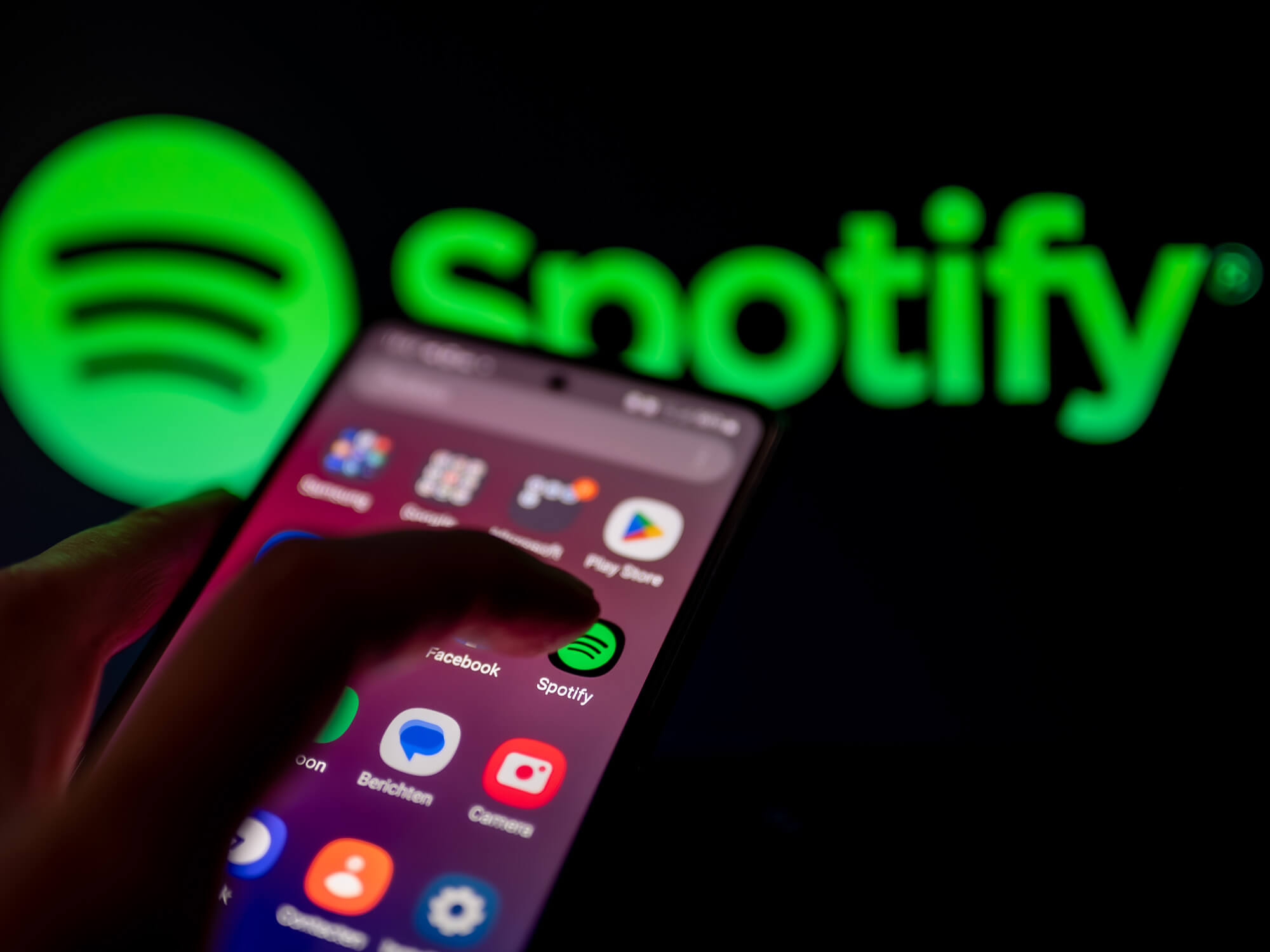On Sunday night, a reported 113 million global viewers watched Kendrick Lamar’s half-time spectacle at the Super Bowl LIX, as the Philadelphia Eagles triumphed over the Kansas City Chiefs. And how did the annual musical show-stopper begin? With a graphic of Apple’s bright red Apple Music branding consuming the exterior of the Caesars Superdome in New Orleans. You can watch the performance — and its bold branding — on the official NFL YouTube channel, in a video titled Kendrick Lamar’s Apple Music Super Bowl Halftime Show. It’s currently sitting at a cool 41 million views.
Seemingly few eyebrows were raised about the $3.5 trillion-dollar company being the Robin to Kendrick’s Batman that night. Would we have seen a similar non-reaction if Spotify fronted the purported $50 million to sponsor the Big Game with such brash commercialisation? Doubtful.
Spotify has become the music supervillain in the past few years. The streaming giant comes under constant scrutiny for its infamously low royalties payout (as low as $0.003), despite CEO Daniel Ek defending its $10 billion payouts to the music industry; Ek himself is slammed by fans, artists and music professionals for his hot takes, eye-bulging shares cashouts and huge investments into arms manufacturers; Spotify users were even disappointed by the alleged use of generative AI to roll out its beloved Spotify Wrapped feature, citing inaccurate facts and poor graphic design. And that’s without the lawsuits and the UK government’s calls for Spotify to be reformed.
Spotify is, however, the most-used streaming service on the planet. It reported a total of 640 million users in 2024, while Apple Music is way behind at 93 million, as last reported by Statista in 2023.
Apple Music, meanwhile, appears to be viewed one of the good guys among the streaming giants (Spotify, Apple Music, YouTube Music, Tidal and Amazon Music). Apple Inc is, of course, critiqued regularly for some of its business practices and product blunders. But the only real negative press that Apple Music gets as a streaming service is about the UX of its app, with reviewers and users bemoaning its clunky navigation. That’s a pretty minor gripe when looking at Spotify’s troubles.

Tim Cook’s Cupertino tech behemoth often wins brownie points for its coverage of new music and engagement with music culture via its in-app radio station Apple Music 1. Frankly, its radio- and podcast-style content is outstanding, with unparalleled artist access to superstars including Billie Eilish and FINNEAS, Taylor Swift, and, yes, definitely Kendrick Lamar.
Following Lamar’s sweep at the Grammys, Apple Music conducted The Official Kendrick Lamar Interview on 6 Feb 2025. It was published on Apple Music’s YouTube, where it has 680,000 views at the time of writing, and was plastered across the Home Screen of the Apple Music app. Apple also celebrated Lamar with a bespoke editorial feature on Apple News, a “special Fitness+ Artist spotlight” and a radio segment by Apple Music Radio host Ebro Darden titled Kendrick Lamar: Hip-Hop’s MVP.
Yes, that’s all a little overkill. We could speculate all the reasons that Apple is buying into Lamar so aggressively right now (literally buying? That part’s not clear…), but the point here is that Apple’s regular high-profile devotion to artists is partly what gives the streaming service such a positive image. Billie Eilish was crowned Apple Music’s Artist Of The Year in 2024 and partnered with the brand on her 2021 album, Happier Than Ever for an exclusive listening experience. The infamous 100 Best Albums list gave flowers to some of music’s most revered artists and albums, and the platform was the frontrunner in adopting and promoting spatial audio with Dolby Atmos, which prompted many classic tracks to get a rerelease (although did receive some criticism of its own). For producers using Apple’s DAW, Logic Pro, there’ll likely be an appreciation towards Apple which could extend to Apple Music. Elton John even has his own radio show on Apple Music, along with many other iconic artists. Certainly this level of artist synergy and integration made Apple Music a natural fit for the halftime show’s primary sponsor, a slot the company took over from Pepsi in 2022.
It’s still far from a perfect platform, though. As producer Benn Jordan pointed out in January, Apple Music’s royalties are around double that of Spotify and YouTube Music at $0.0061 but aren’t exactly industry-leading — Tidal and Amazon Music (and Peloton) are winning in that arena. And, while all of Apple Music’s editorial coverage likely stems from a passion amongst its employees, it’s ultimately all in place to promote the service and Apple’s product catalogue rather than the artist. The Super Bowl show was, naturally, concluded with a limited-time offer to join Apple Music. As always, it’s all marketing.
That’s likely how Apple comes out on top. It’s been the master brand of marketing since Steve Jobs began stepping out onto the stage to announce iPods, iPhones and iMacs in his ‘Stevenote’ presentations. Today, Apple’s virtual Events are circled on the calendars of every tech and music publication, and music plays a key role here, too, often giving lesser-known artists a nod in the Event’s backing track.
Spotify doesn’t appear as interested in being a music platform — it prefers to be a streaming platform. There was a Spotify x FanDuel Super Bowl party with Blink-182, Megan Thee Stallion and Anderson. Paak performing, one of many music-centric events that took place around New Orleans during Super Bowl weekend. But, over on the Spotify app, But, over on the app, it uses an AI DJ to curate your music, rather than commission actual DJs to record mixes, and there’s potential for us to see even more AI-created music on Spotify following the comments of co-president Gustav Söderström. The push on podcasting content — notably that $250 million Joe Rogan Experience deal — seemed to alienate some musicians and fans from the audio streaming platform.
But does Apple Music’s integration with the wider music scene translate to better financial support for musicians? Well, maybe for the bigger artists. Apple says it pays an average of $0.01 per play, contrary to Benn Jordan’s point, but is likely based on the stream share model it employs. This means, hypothetically, if Kendrick Lamar gets 5 per cent of the total streams on Apple Music this month, he’s entitled to 5 per cent of all royalties from the platform. Will Kendrick get more plays as a result of Apple Music’s coverage and sponsorship? You can count on it — particularly given that, as announced by Roc Nation, the NFL and Apple Music on Tuesday, Lamar’s performance was the most watched Super Bowl halftime show performance of all time, with 133.5 million viewers (Even Spotify wins from this success, with the platform announcing that Lamar’s catalogue saw a 430% streaming bump in the days after the game).
Acknowledging its streaming model in a 2021 article, Apple said: “Like other [streaming platforms], we have looked at alternative royalty models. Our analysis has shown that they would result in a limited redistribution of royalties with a varied impact on artists. Per play, rates would cease to be the same for every play of a song. But more importantly, the changes would not increase what all creators earn from streaming. Instead, these changes would shift royalties towards a small number of labels while providing less transparency to creators everywhere.”
The truth is, as many artists will tell you, there isn’t a ‘good guy’ among the streaming giants right now. The only heroes, really, are the fans that buy digital and physical copies of artist’s music, go to their shows, and (in our modern world) subscribe to their direct-to-fan platforms.
Still, Apple Music seems well-positioned. Elton John, Lauryn Hill, Kacey Musgraves and more thanked Apple Music when their albums were ranked in the brand’s 100 Best Albums awards in 2024. How often do you hear musicians thanking Spotify?
Read more music technology news.






